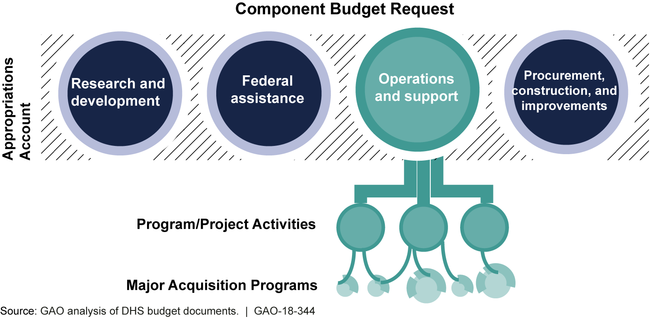DHS Program Costs: Reporting Program-Level Operations and Support Costs to Congress Would Improve Oversight
Fast Facts
Up to 70% of acquisition costs can be incurred after a system or an asset—like a Coast Guard cutter—is deployed. Generally, these are the costs of operating, staffing, and maintaining the acquisition.
But we found that the Department of Homeland Security's budget reporting aggregates these operations and support costs by mission, rather than by individual acquisition program. Therefore, Congress doesn't know how much DHS is actually spending on each acquisition.
We recommended adding this level of detail to DHS's budget report for Congress and other key financial reports.

Three photographs show a helicopter, a Coast Guard cutter, and a luggage scanner.
Highlights
What GAO Found
While the Department of Homeland Security's (DHS) budget management provides flexibility to conduct operations, such as shifting funds to programs within the same mission area to cover unforeseen needs, budget reporting does not provide Congress with insight into specific programs' operations and support O&S costs. The O&S budget information that DHS reports to Congress is oriented by mission—for example, Integrated Operations—instead of by program—for example, the Multi-Role Enforcement Aircraft Program. The figure depicts the mission-oriented nature of the budget.
Department of Homeland Security's Budget Structure

While some program-oriented O&S data are available at the component level, this information does not appear in DHS's budget reports to Congress. This disparity is due in part to the manner in which the department reports budget information. However, these limitations are not insurmountable. Standards for internal controls state that managers should communicate quality information, in this case full program costs. Providing additional data on O&S costs in budget reports would preserve DHS's flexibility in its use of funds while providing Congress a better understanding of the budgetary and programmatic effect of its funding decisions.
GAO reviewed the O&S portion of the most recently approved cost estimates for selected programs and found that 10 of the 11 estimates provided a complete accounting of all resources and associated cost elements. Further, all the programs had appropriately updated their cost estimates as required, a GAO best practice in cost estimating. Due to the sensitive nature of some programs' cost models, GAO could not verify all aspects of accuracy for all estimates reviewed.
Why GAO Did This Study
O&S costs—the costs used to operate and sustain a program—can account for up to 70 percent of a program's total cost. End users rely on O&S funds for maintenance, spares, and personnel. DHS programs initially identify O&S costs in their life-cycle cost estimate at the outset of the acquisition. This estimate informs the program's budget and affects the amount the department designates for the program's use. In 2015, GAO found that DHS's budget requests did not reflect all estimated costs—including O&S—for certain programs, which limits visibility for decision makers.
GAO was asked to review O&S activities for major acquisition programs at DHS. This report examines the extent that (1) DHS's budget management and reporting affects operations and oversight, and (2) cost estimates are comprehensive and accurate, as well as regularly updated.
GAO selected a non-generalizable sample of 11 major acquisition programs, based on asset type and acquisition status, as case studies from selected DHS components. GAO analyzed selected programs' O&S cost estimates, funding, and spending. In addition, GAO interviewed DHS officials at the headquarters, component, and program office level.
Recommendations
GAO is making three recommendations, including that DHS work with Congress to add program-level O&S funding details to the budget information it provides Congress. DHS concurred.
Recommendations for Executive Action
| Agency Affected | Recommendation | Status |
|---|---|---|
| Department of Homeland Security | The Secretary of Homeland Security should work with Congress to add information to its annual congressional budget justification to show O&S funding requests for major acquisition programs within current program/project activity accounts. (Recommendation 1) |
DHS agreed with this recommendation and added operations and support funding information for major acquisition programs to its congressional budget justification for fiscal year 2021.
|
| Department of Homeland Security | The Secretary of Homeland Security should work with Congress to include O&S data in monthly execution reports at a major acquisition program level within current program/project activity accounts. (Recommendation 2) |
DHS concurred with this recommendation and developed a display that provides major acquisition programs' O&S data at the program project activity level. As of June 2023, all of the DHS components we reviewed can now report their O&S data in keeping with our recommendation.
|
| Department of Homeland Security | The DHS Chief Financial Officer should reverse the exclusion of O&S funding at a major acquisition program level in its Future Years Homeland Security Program report for all components. (Recommendation 3) |
DHS concurred with this recommendation and added operations and support funding information for the major acquisition programs of all of its components to the Future Years Homeland Security Program report issued in 2019.
|
